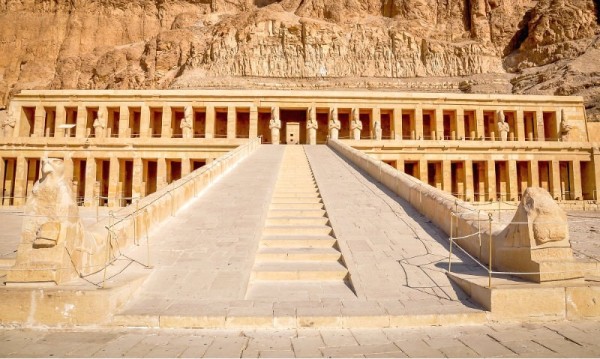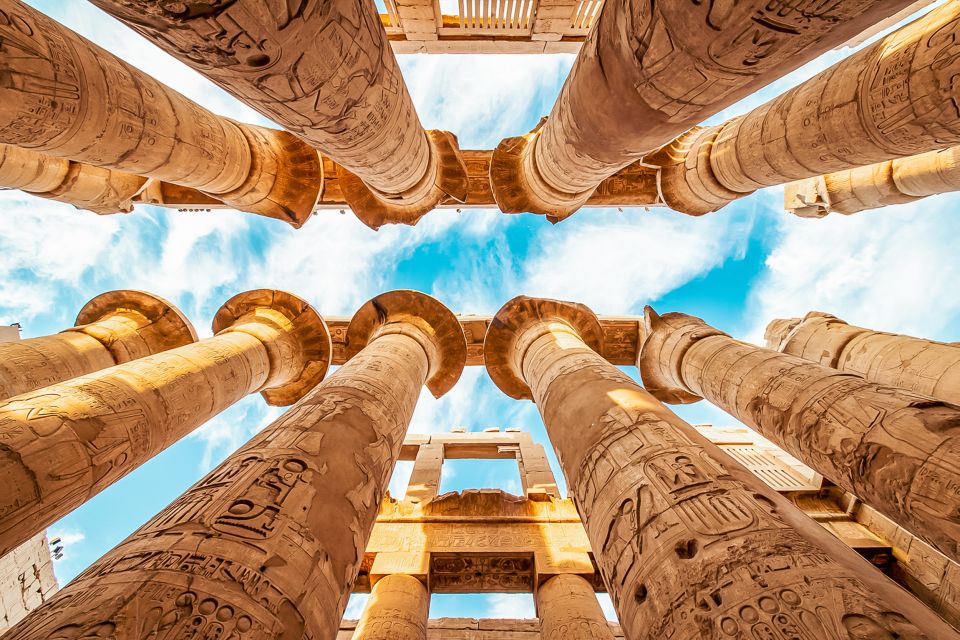Luxor
Explore the place

Découvrez les Merveilles de Louxor : Un Voyage à Travers l'Histoire de l'Égypte Ancienne
Rejoignez-nous pour un voyage extraordinaire à Louxor, l'ancienne capitale de l'Égypte, souvent considérée comme le plus grand musée en plein air du monde. Louxor, située en Haute-Égypte, était la ville historique de Thèbes pendant les périodes du Moyen et du Nouvel Empire. Aujourd'hui, Louxor est connue pour ses temples majestueux et la célèbre Vallée des Rois, un lieu d'une importance archéologique exceptionnelle.
Louxor se trouve sur les rives du Nil et compte environ 1,3 million d'habitants. Elle abrite certaines des découvertes les plus significatives de l'Égypte ancienne. Sur la rive est du Nil se trouve la ville moderne, où vous pourrez visiter le célèbre temple de Louxor et le complexe du temple de Karnak. Karnak est célèbre pour sa salle hypostyle avec ses 134 colonnes massives. L'ancienne ville, connue sous le nom arabe d'Al-Uqsur (« Les Palais »), était historiquement divisée par un canal en deux zones : Louxor au sud et Karnak au nord.
Aujourd'hui, bien qu'une grande partie de Thèbes ait été détruite à l'époque ptolémaïque, les vestiges de son passé glorieux continuent d'attirer des visiteurs du monde entier. Cette ville historique offre un aperçu de la civilisation sophistiquée qui a prospéré le long du Nil, remontant à 3150 avant J.-C., lorsque l'Égypte du Haut et du Bas a été unifiée sous le premier pharaon.
Voici quelques-uns des lieux remarquables que vous pouvez explorer à Louxor :
1. Le Complexe du Temple de Karnak
Karnak est un ensemble monumental de temples, chapelles, statues et autres bâtiments situés dans l'ancienne ville de Thèbes. Dédicacé au dieu suprême Amon-Ra, Karnak a été conçu pour inspirer l'émerveillement et la vénération spirituelle. Les visiteurs peuvent admirer les détails artistiques de la salle hypostyle et explorer les vastes cours, obélisques et sanctuaires qui illustrent le génie architectural de l'Égypte ancienne.
2. La Vallée des Rois (Biban El-Muluk)
Cette vallée emblématique abrite les tombes des pharaons des XVIIIe, XIXe et XXe dynasties, couvrant plus de 500 ans de règne. Contrairement aux pharaons précédents, qui étaient enterrés dans des pyramides, les souverains de Thèbes ont choisi des tombes cachées, taillées dans la roche, afin de protéger leurs trésors des pilleurs. Certaines des tombes les plus célèbres d'Égypte se trouvent ici, et l'artisanat complexe de ces tombes continue de fasciner les visiteurs.
3. Le Temple de Hatschepsout (Deir el-Bahari)
Ce temple funéraire dédié à la pharaonne Hatschepsout est un hommage à son héritage. Conçu par son architecte Senemut, le temple présente des cours terrassées ornées de sculptures et de gravures complexes. Malgré les destructions causées par son beau-fils, qui a tenté d'effacer son héritage, le temple reste un témoignage extraordinaire de son règne et de son dévouement à Amon-Ra.
4. Visite Optionnelle de la Tombe de Toutankhamon
Découverte en 1922 par Howard Carter, la tombe de Toutankhamon, également connue sous le nom de « Roi Tout », est l'une des découvertes archéologiques les plus importantes de l'ère moderne. Aujourd'hui, les artefacts de sa tombe, y compris son célèbre masque en or de 10 kilogrammes, ont été minutieusement remontés et sont exposés au nouveau Grand Musée Égyptien. Cette collection offre un aperçu du court mais marquant règne du « roi enfant », qui régna sous la XVIIIe dynastie.
5. Visite Optionnelle de la Tombe de Ramsès VI
La tombe de Ramsès VI, initialement construite pour Ramsès V puis agrandie, est l'une des plus grandes de la Vallée des Rois. Ses gravures complexes et les cartouches pharaoniques détaillés illustrent la grandeur de l'art égyptien. Malgré des siècles de pillages et de réutilisations, la tombe reste un magnifique vestige du passé de l'Égypte.
Beaucoup de tombes dans la Vallée des Rois ont été pillées au fil du temps, mais elles conservent une incroyable signification historique et culturelle.
L'équipe RA est prête à vous guider à travers les merveilles de Louxor, vous offrant un voyage inoubliable au cœur de l'Égypte ancienne !




